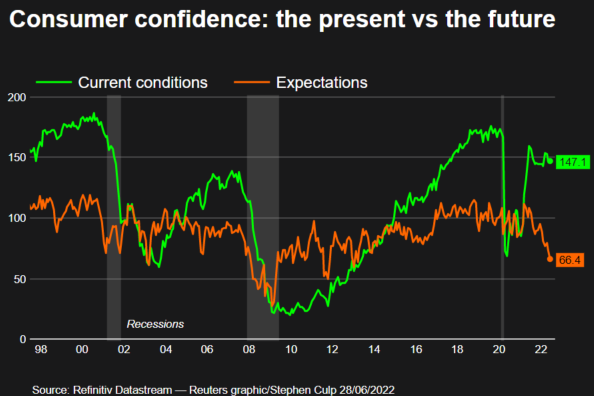Wall Street Tumbles As Consumer Data Fuels Recession Worries

Wall Street slid on Tuesday with early gains reversing to a broad sell-off on the heels of dire consumer confidence data, which dampened investor optimism and stoked recession fears.
All three major U.S. stock indexes were sharply lower, with the tech-laden Nasdaq declining the most. Amazon.com, Microsoft Corp and Apple Inc were the heaviest drags.
With the end of the month and the second quarter a mere two days away, the benchmark S&P 500 is on track for its biggest first-half percentage drop since 1970.
All three indexes are on course to notch two straight quarterly declines for the first time since 2015.
"It has been a very bad start to the year, and 1970 is a pretty good analog to where we are now, with war and inflation," said Peter Tuz, president of Chase Investment Counsel in Charlottesville, Virginia.
Data released on Tuesday morning showed the Conference Board's consumer confidence index dropping to the lowest it has been since February 2021, with near-term expectations reaching its most pessimistic level in nearly a decade.
The growing gap between the Conference Board's "current situation" and "expectations" components have widened to levels that often precede recession:
Graphic: Consumer confidence -

The Dow Jones Industrial Average fell 344.19 points, or 1.09%, to 31,094.07, the S&P 500 lost 60.5 points, or 1.55%, to 3,839.61 and the Nasdaq Composite dropped 283.90 points, or 2.46%, to 11,240.66.
Of the 11 major sectors in the S&P 500, consumer discretionary was suffering the largest percentage loss. Energy stocks was the biggest gainer, benefiting from rising crude prices. [O/R]
With few market catalysts and market participants gearing up for the July Fourth holiday weekend, Tuz cautions against reading too much into daily index moves.
"One doesn't want to make much of this week - it's a pre-holiday week," Tuz added. "The real action is going to start in about 10 days, when companies start reporting earnings and providing guidance."
With several weeks to go until second-quarter reporting commences, 130 S&P 500 companies have pre-announced. Of those, 45 have been positive and 77 have been negative, resulting in a negative/positive ratio of 1.7 stronger than the first quarter but weaker than a year ago, according to Refinitiv data.
Nike Inc slid 6.3% after forecasting lower than expected first-quarter revenue.
Shares of Occidental Petroleum Corp advanced 3.1% after Warren Buffett's Berkshire Hathaway Inc raised its stake in the company.
Declining issues outnumbered advancing ones on the NYSE by a 1.56-to-1 ratio; on Nasdaq, a 2.23-to-1 ratio favored decliners.
The S&P 500 posted one new 52-week high and 29 new lows; the Nasdaq Composite recorded 25 new highs and 98 new lows.
© Copyright Thomson Reuters 2024. All rights reserved.




















